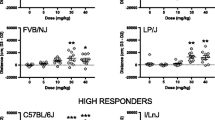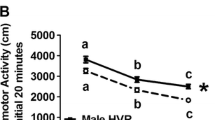Abstract
Rationale
The psychomotor stimulant properties of drugs are argued to be a key feature of abuse liability. Several studies, primarily using inbred strains of mice, have demonstrated genetic variation in the psychomotor stimulant properties of cocaine. As of yet, however, no gene(s) has been identified which influences this phenotype.
Objectives
The purpose of the present study was to examine a number of inbred strains of mice, including several closely related substrains, for cocaine-induced locomotor activation. Such substrain differences would suggest the possibility of a major gene effect. These data will also help to further characterize the range of genetic variation in response to cocaine.
Methods
Mice from 11 inbred strains were initially injected with saline and activity monitored for 30 min; mice were then removed from the activity monitor, injected with saline or one of six doses of cocaine, and activity was monitored for an additional 30 min.
Results
Compared to several other closely related C57BL substrains, we found the C57BL/10SnJ substrain to be significantly less activated following cocaine administration. In contrast, the C57BR/cdJ and C57L/J substrains showed extremely high levels of cocaine-induced locomotor activation.
Conclusions
The genetic similarity between C57BL/10SnJ and the other closely related C57BL substrains suggests the possibility that the aberrant behavioral response to cocaine observed in B10SnJ mice may be due to a major gene effect. Similarly, the differences found in the C57BR/cdJ and C57L/J substrains may also be influenced by a major gene. The strains examined in this study will be useful tools for identification of relevant quantitative trait loci.







Similar content being viewed by others
References
Benuck M, Lajtha A, Reith ME (1987) Pharmacokinetics of systemically administered cocaine locomotor stimulation in mice. J Pharmacol Exp Ther 243:144–149
Boyle AE, Gill K (2001) Sensitivity of AXB/BXA recombinant inbred lines of mice to the locomotor activating effects of cocaine: a quantitative trait loci analysis. Pharmacogenetics 11:255–264
Crabbe JC, Weigel RM (1987) Quantification of individual sensitivities to ethanol in selective breeding experiments: difference scores versus regression residuals. Alcohol Clin Exp Res 11:544–549
Crabbe JC, Wahlsten D, Dudek BC (1999) Genetics of mouse behavior: Interactions with lab environment. Science 284:1670–1674
Crawley JN, Belknap JK, Collins A, Crabbe JC, Frankel W, Henderson N, Hitzemann RJ, Maxson SC, Miner LL, Silva AJ, Wehner JM, Wynshaw-Boris A, Paylor R (1997) Behavioral phenotypes of inbred mouse strains: implications and recommendations for molecular studies. Psychopharmacology 132:107–124
Cunningham CL, Dickinson SD, Grahame NJ, Okorn SD, McMullin CS (1999) Genetic differences in cocaine induced conditioned place preference in mice depend on conditioning trial duration. Psychopharmacology 146:73–80
Deroche V, Caine SB, Heyser CJ, Polis I, Koob GF, Gold LH (1997) Differences in the liability to self-administer intravenous cocaine between C57BL/6×SJL and BALB/cByJ mice. Pharmacol Biochem Behav 57:429–440
Dudek BC, Tritto T (1995) Classical and neoclassical approaches to the genetic analysis of alcohol-related phenotypes. Alcohol Clin Exp Res 19:802–810
Festing MFW (1979) Inbred strains in biomedical research. Oxford University Press, New York
George FR, Ritz MC (1990) Cocaine produces locomotor stimulation in SS but not LS mice: relationship to dopaminergic function. Psychopharmacology 101:18–22
Grahame NJ, Cunningham CL (1995) Genetic differences in intravenous cocaine self- administration between C57BL/6J and DBA/2J mice. Psychopharmacology 122:281–291
Henricks KK, Miner LL, Marley RJ (1997) Differential cocaine sensitivity between two closely related substrains of C57BL mice. Psychopharmacology 132:161–168
Jaccard J (1998) Interaction effects in factorial analysis of variance. Quantitative applications in the social sciences series #118. C A Sage University Press, Thousand Oaks, pp 38–39
Jones BC, Reed CL, Radcliffe RA, Erwin VG (1993) Pharmacogenetics of cocaine: I. Locomotor activity and self-selection. Pharmacogenetics 3:182–188
Jones BC, Tarantino LM, Rodriguez LA, Reed CL, McClearn GE, Plomin R, Erwin VG (1999) Quantitative-trait loci analysis of cocaine-related behaviours and neurochemistry. Pharmacogenetics 9:607–617
Karkowski LM, Prescott CA, Kendler KS (2000) Multivariate assessment of factors influencing illicit substance use in twins from female-female pairs. Am J Med Gen 96:665–670
Kendler KS, Prescott CA (1998) Cocaine use, abuse and dependence in a population-based sample of female twins. Br J Psychiatry 173:345–350
Kendler KS, Karkowski LM, Neale MC, Prescott CA (2000) Illicit psychoactive substance use, heavy use, abuse, and dependence in a US population-based sample of male twins. Arch Gen Psychiatry 57:261–269
Marley RJ, Arros DM, Henricks KK, Marley ME, Miner LL (1998) Sensitivity to cocaine and amphetamine among mice selectively bred for differential cocaine sensitivity. Psychopharmacology 140:42–51
Miner LL (1997) Cocaine reward and locomotor activity in C57BL/6J and 129/SvJ mice and their F1 cross. Pharmacol Biochem Behav 58:25–30
Miner LL, Marley RJ (1995) Chromosomal mapping of the psychomotor stimulant effects of cocaine in BXD recombinant inbred mice. Psychopharmacology 122:209–214
Newlin DB, Thomson JB (1991) Chronic tolerance and sensitization to alcohol in some of alcoholics. Alcohol Clin Exp Res 15:399–405
Phillips TJ, Burkhart-Kasch S, Terdal E, Crabbe JC (1991) Response to selection for EtOH-induced locomotor activation: genetic analyses and selection response characterization. Psychopharmacology 103:557–566
Phillips TJ, Huson MG, McKinnon CS (1998) Localization of genes mediating acute and sensitized locomotor responses to cocaine in BXD/Ty recombinant inbred mice. J Neurosci 18:3023–3034
Reith ME, Selmeci G (1991) Cocaine binding sites in mouse striatum, dopamine autoreceptors, and cocaine-induced locomotion. Pharmacol Biochem Behav 41:227–230
Reith MEA, Benuck M, Lajtha A (1987) Cocaine disposition in the brain after continuous or intermittent treatment and locomotor stimulation in mice. J Pharmacol Exp Ther 243:281–287
Rocha BA, Odom LA, Barron BA, Ator R, Wild SA, Forster MJ (1998) Differential responsiveness to cocaine in C57BL/6J and DBA/2J mice. Psychopharmacology 138:232–88
Rosenthal R, Rosnow RL (1985) Contrast analysis: Focused comparisons in the analysis of variance. Cambridge University Press, Cambridge
Ruth JA, Ullman EA, Collins AC (1988) An analysis of cocaine effects on locomotor activities and heart rate in four inbred mouse strains. Pharmacol Biochem Behav 29:157–162
Schlussman SD, Ho A, Zhou Y, Curtis AE, Kreek MJ (1998) Effects of "binge" pattern cocaine on stereotypy and locomotor activity in C57BL/6J and 129/J mice. Pharmacol Biochem Behav 60:593–599
Seale TW, Carney JM (1991) Genetic determinants of susceptibility to the rewarding and other behavioral actions of cocaine. J Addict Dis 10:141–162
Silver LM (1995) Mouse genetics: concepts and applications. Oxford University Press, New York
Smolen A, Marks MJ (1991) Genetic selections for nicotine and cocaine sensitivity in mice: J Addict Dis 10:7–28
Tolliver BK, Carney JM (1994) Comparison of cocaine and GBR 12935: Effects on locomotor activity stereotypy in two inbred mouse strains. Pharmacol Biochem Behav 48:733–739
Tolliver BK, Carney TM (1995) Locomotor stimulant effects of cocaine and novel cocaine analogs in DBA/2J and C57BL/6J inbred mice. Pharmacol Biochem Behav 50:163–169
Tolliver BK, Belknap JK, Woods WE, Carney JM (1994) Genetic analysis of sensitization and tolerance to cocaine. J Pharmacol Exp Ther 270:1230–1238
Tritto T, Dudek BC (1994) Differential activating effects ofethanol in C57BL/6Abg and DBA/2Abg mice. Alcohol 11:133–139
Wiener HL, Reith ME (1990) Correlation between cocaine-induced locomotion and cocaine disposition in the brain among four inbred strains of mice. Pharmacol Biochem Behav 36:699–701
Wise RA, Bozarth MA (1987) A psychomotor stimulant theory of addiction. Psychol Rev 94:469–492
Womer DE, Jones BC, Erwin VG (1994) Characterization of dopamine transporter and locomotor effects of cocaine, GBR 12909, epidepride, and SCH 23390 in C57BL and DBA mice. Pharmacol Biochem Behav 48:327–335
Acknowledgements
This research was supported by grants RO1 DA10731 (R.J.M. and B.C.D.) and RO1 AA9038 and KO2 AA00170 (B.C.D.).
Author information
Authors and Affiliations
Corresponding author
Rights and permissions
About this article
Cite this article
Downing, C., Rodd-Henricks, K., Marley, R.J. et al. Genetic variation in the psychomotor stimulant properties of cocaine in Mus musculus . Psychopharmacology 167, 159–166 (2003). https://doi.org/10.1007/s00213-003-1387-0
Received:
Accepted:
Published:
Issue Date:
DOI: https://doi.org/10.1007/s00213-003-1387-0




